Difference between revisions of "Conditional Import for OnePager Express Add-in for Version 6.0"
(→Overview) |
(→Overview) |
||
| Line 9: | Line 9: | ||
:(2) Then, we'll cover a couple of examples on how you might use the '''Condition Import Filters''' feature in your every day use of OnePager in preparation for your schedule presentations and discussions. | :(2) Then, we'll cover a couple of examples on how you might use the '''Condition Import Filters''' feature in your every day use of OnePager in preparation for your schedule presentations and discussions. | ||
| − | :(3) Finally, we’ll provide details on how '''Conditional Import Filters''' works with (a) Microsoft | + | :(3) Finally, we’ll provide details on how '''Conditional Import Filters''' works with (a) multiple Microsoft Excel files in one '''source plan''' and (b) with Microsoft Excel '''source plans''' consisting of several separate files. |
| − | + | ||
==Adding a Filter Rule to the Conditional Import Rules Form== | ==Adding a Filter Rule to the Conditional Import Rules Form== | ||
| − | 1) The '''Conditional Import Rules''' form resembles to the ''' | + | 1) The '''Conditional Import Rules''' form resembles to the '''Conditional Formatting''' form in look and function. In this form you can add, copy, change, and delete '''Conditional Import Filters''' rules. The form is accessed from the '''OnePager choices '''('''OPC''') form as shown below: |
<center>[[File:X60-7_18_2_1-60-(1AA)-03072017.png]]</center> | <center>[[File:X60-7_18_2_1-60-(1AA)-03072017.png]]</center> | ||
<!--<center>X60-7_18_2_1-60-(1AA)-03072017.png</center>--> | <!--<center>X60-7_18_2_1-60-(1AA)-03072017.png</center>--> | ||
| − | :a) The '''Conditional Import Rules''' form is shown in its initial blank state above. The rules entered | + | :a) The '''Conditional Import Rules '''form is shown in its initial blank state above. The rules entered become part of any project view subsequently created or updated and are saved with the project view. If you later, create or update a snapshot using a '''flag''' field, '''OPX''' will save the '''flag''' field and clear the '''Conditional Import Filters''' rules. |
| − | :b) '''Conditional Import | + | :b) '''Conditional Import Filter''' rules are typically entered when a project view is first created in the '''NEW''' workflow |
| − | :c) After a project view is created | + | :c) After a project view is created, rules may be added later for the '''UPDATE''' workflow via the '''OnePager Choices''' form invoked either from the '''OnePager Start''' form or the '''Project View Editor''' ('''Custom Update…''' button. These workflows are described later in this article. |
| − | 2) With the '''Custom Import Rules''' form visible and blank, | + | 2) With the '''Custom Import Rules''' form visible and blank, click the '''Add Rule''' button to create a new empty row as shown below: |
<center>[[File:X60-7_18_2_1-60-(2AA)-03072017.png]]</center> | <center>[[File:X60-7_18_2_1-60-(2AA)-03072017.png]]</center> | ||
| Line 34: | Line 33: | ||
::i) The first two cells are used as '''selection''' cells. | ::i) The first two cells are used as '''selection''' cells. | ||
::ii) The first left-most cell, when clicked, allows you to use the '''Copy Rule(s)''' or the '''Delete Rule(s)''' buttons. | ::ii) The first left-most cell, when clicked, allows you to use the '''Copy Rule(s)''' or the '''Delete Rule(s)''' buttons. | ||
| − | ::iii) The second cell from the left is a checkbox used to allow you to '''activate''' | + | ::iii) The second cell from the left is a checkbox used to allow you to '''activate''' or '''deactivate''' the rule. If the checkbox is '''unchecked''', '''OPX''' will not apply the rule when performing the '''import''' function. |
| − | :b) The '''Field''' cell of a row (third from the left) has a dropdown menu that allows you to select a Microsoft Excel '''source plan''' field to use in creating the | + | :b) The '''Field''' cell of a row (third from the left) has a dropdown menu that allows you to select a Microsoft Excel '''source plan''' field to use in creating the selected criterion. When the dropdown menu is selected, the '''Field '''cell will look something like this: |
<center>[[File:X60-7_18_2_1-60-(3AA)-03072017.png]]</center> | <center>[[File:X60-7_18_2_1-60-(3AA)-03072017.png]]</center> | ||
| Line 45: | Line 44: | ||
:d) The look of the rest of the new '''Conditional Import Filters''' rule row depends on the type of the Microsoft Excel '''source plan''' field selected. These types are discussed next. | :d) The look of the rest of the new '''Conditional Import Filters''' rule row depends on the type of the Microsoft Excel '''source plan''' field selected. These types are discussed next. | ||
| − | 3) '''Date and Numeric Fields – ''' When Microsoft Excel '''date or numeric''' types are | + | 3) '''Date and Numeric Fields – ''' When Microsoft Excel '''date or numeric''' types are selected in the '''Field''' cell of the rule row, the '''Operator''' field dropdown will provide the options shown below: |
<center>[[File:X60-7_18_2_1-60-(4AA)-03072017.png]]</center> | <center>[[File:X60-7_18_2_1-60-(4AA)-03072017.png]]</center> | ||
<!--<center>X60-7_18_2_1-60-(4AA)-03072017.png</center>--> | <!--<center>X60-7_18_2_1-60-(4AA)-03072017.png</center>--> | ||
| − | :a) These are the conventional six (6) logical operators used consistently in '''OPX''' for date and numeric types. They are the same '''Operators''' used in '''OPX''' for '''Conditional Formatting'''. See the article at [[Conditional Formatting Overview for OnePager Express for Version 6.0 | Conditional Formatting Overview-OnePager Express]] <!--11.2.1-60--> for | + | :a) These are the conventional six (6) logical operators used consistently in '''OPX''' for date and numeric types. They are the same '''Operators''' used in '''OPX''' for '''Conditional Formatting'''. See the article at [[Conditional Formatting Overview for OnePager Express for Version 6.0 | Conditional Formatting Overview-OnePager Express]] <!--11.2.1-60--> for complementary details on the use of these logical operators. |
| − | :b) | + | :b) When the logical statement evaluates to '''TRUE''' on the selected '''Field''' in a Microsoft Excel '''source plan''' row, the row is imported. Otherwise it is skipped. |
4) '''Text Fields – ''' When Microsoft Excel '''text''' types are entered in the '''Field''' cell of the '''Conditional Import Filters''' rule row, the '''Operator''' field dropdown will provide the options shown below: | 4) '''Text Fields – ''' When Microsoft Excel '''text''' types are entered in the '''Field''' cell of the '''Conditional Import Filters''' rule row, the '''Operator''' field dropdown will provide the options shown below: | ||
| Line 59: | Line 58: | ||
<!--<center>X60-7_18_2_1-60-(5AA)-03072017.png</center>--> | <!--<center>X60-7_18_2_1-60-(5AA)-03072017.png</center>--> | ||
| − | :a) These are the conventional four (4) logical operators used consistently in '''OPX''' for the text type. They are the same '''Operators''' used in '''OPX''' for '''Conditional Formatting'''. See the article at [[Conditional Formatting Overview for OnePager Express for Version 6.0 | Conditional Formatting Overview-OnePager Express]] <!--11.2.1-60--> for | + | :a) These are the conventional four (4) logical operators used consistently in '''OPX''' for the text type. They are the same '''Operators''' used in '''OPX''' for '''Conditional Formatting'''. See the article at [[Conditional Formatting Overview for OnePager Express for Version 6.0 | Conditional Formatting Overview-OnePager Express]] <!--11.2.1-60--> for complementary details on the use of these logical operators. |
| − | :b) | + | :b) When the logical statement evaluates to '''TRUE''' on the selected '''Field''' in a Microsoft Excel '''source plan''' row, the row is imported. Otherwise it is skipped. |
5) '''Boolean Fields – ''' When Microsoft Excel '''Boolean''' types are entered in the '''Field''' cell of the '''Conditional Import Filters''' rule row, the '''Operator''' field dropdown will provide the options shown below: | 5) '''Boolean Fields – ''' When Microsoft Excel '''Boolean''' types are entered in the '''Field''' cell of the '''Conditional Import Filters''' rule row, the '''Operator''' field dropdown will provide the options shown below: | ||
| Line 68: | Line 67: | ||
<!--<center>X60-7_18_2_1-60-(6AA)-03072017.png</center>--> | <!--<center>X60-7_18_2_1-60-(6AA)-03072017.png</center>--> | ||
| − | :a) These are the two (2) conventional Boolean logical operators used consistently in '''OPX''' for the Boolean type. They are the same '''Operators''' used in '''OPX''' for '''Conditional Formatting'''. See the article at [[Conditional Formatting with Boolean Fields for OnePager Express for Version 6.0 | Conditional Formatting with Boolean Fields for OnePager Express]] <!--11.6.1-60--> for | + | :a) These are the two (2) conventional Boolean logical operators used consistently in '''OPX''' for the Boolean type. They are the same '''Operators''' used in '''OPX''' for '''Conditional Formatting'''. See the article at [[Conditional Formatting with Boolean Fields for OnePager Express for Version 6.0 | Conditional Formatting with Boolean Fields for OnePager Express]] <!--11.6.1-60--> for complementary details on the use of these logical operators. |
:b) Boolean types are a special case as the '''operator''' and the '''value''' in '''OPX''' are combined into one cell of the '''Conditional Import''' rule row - the '''Operator''' cell. | :b) Boolean types are a special case as the '''operator''' and the '''value''' in '''OPX''' are combined into one cell of the '''Conditional Import''' rule row - the '''Operator''' cell. | ||
| − | :c) | + | :c) When the selected Field is '''TRUE''' (or '''Yes''') in a Microsoft Excel '''source plan''' row, the row is imported. Otherwise it is skipped. |
| − | 6) '''Text Type Fields used as Flags – ''' '''OPX''' | + | 6) '''Text Type Fields used as Flags – ''' '''OPX''' treats Microsoft Excel '''Text''' type fields as '''flag''' fields to control row '''imports'''. Accordingly, when '''text''' type fields are used for '''Conditional Import Filters''' rules, '''OPX''' makes the '''import''' decisions based on whether the cell either contains or does not contain to required '''Value''' cell’s content as shown below: |
<center>[[File:X60-7_18_2_1-60-(7AA)-03072017.png]]</center> | <center>[[File:X60-7_18_2_1-60-(7AA)-03072017.png]]</center> | ||
| Line 91: | Line 90: | ||
:a) '''OPX''' treats such Microsoft Excel '''Fields''' as '''Boolean''' types in the same way as described in the previous sub-section. When these Microsoft Excel types are entered in the '''Field''' cell of the '''Conditional Import Filters''' rule row, the '''Operator''' cell dropdown will provide the options as shown above. | :a) '''OPX''' treats such Microsoft Excel '''Fields''' as '''Boolean''' types in the same way as described in the previous sub-section. When these Microsoft Excel types are entered in the '''Field''' cell of the '''Conditional Import Filters''' rule row, the '''Operator''' cell dropdown will provide the options as shown above. | ||
| − | :b) | + | :b) There are the two (2) conventional Boolean logical operators used consistently in '''OPX''' for the Boolean type. They are the same '''Operators''' used in '''OPX''' for '''Conditional Formatting'''. See the article at [[Conditional Formatting with Boolean Fields for OnePager Express for Version 6.0 | Conditional Formatting with Boolean Fields for OnePager Express]] <!--11.6.1-60--> for complementary details on the use of these logical operators. |
| − | + | ||
| − | + | ||
| − | : | + | :c) When the selected Field is '''TRUE''' (or '''Yes''') in a Microsoft Project '''source plan''' row, the row is imported. Otherwise it is skipped. |
| − | + | 7) We want to emphasize the flexibility that '''Conditional Import Filters''' adds to the way you can '''import''' rows from your Microsoft Excel '''source plan'''. You can formulate sets of '''Conditional Import Filters''' rules to controls '''imports''' using '''all available types''' of Microsoft Excel '''fields''' and use operators that let you select ranges of values and more complicated combinations of criteria. | |
==Editing an Existing Filter Rule in the Conditional Import Rules Form== | ==Editing an Existing Filter Rule in the Conditional Import Rules Form== | ||
| Line 118: | Line 115: | ||
<!--<center>X60-7_18_2_1-60-(10AA)-03072017.png</center>--> | <!--<center>X60-7_18_2_1-60-(10AA)-03072017.png</center>--> | ||
| − | :d) Any '''Field, Operator, or Value''' cell may be edited in this way. Additionally, the '''On''' cell may be toggled to control the '''Conditional Import''' rule | + | :d) Any '''Field, Operator, or Value''' cell may be edited in this way. Additionally, the '''On''' cell may be toggled to control the '''Conditional Import''' rule's participation in the '''import''' process. Finally, you may switch between the two radio buttons at the top of the form in order to change the relationship among the rules from '''OR''' to '''AND''' or vice versa. |
| − | :e) The edits described above may be made to the '''Conditional Import Rules''' form regardless of the '''OPC''' mode in which you are working (i.e., '''NEW | + | :e) The edits described above may be made to the '''Conditional Import Rules''' form regardless of the '''OPC''' mode in which you are working (i.e., '''NEW and UPDATE'''). Also, you may bring up the '''Conditional Import Rules''' form from the '''OPC''' form as many times as needed to accomplish your presentation goal. '''OPX''' saves the content of the last edit you make to the '''Conditional Import Rules''' form. |
:f) When satisfied with the structure of your '''import''' rules, click the '''OK''' button at the bottom of the form to return to the '''OPC''' form. Now you are ready to create a new project view. | :f) When satisfied with the structure of your '''import''' rules, click the '''OK''' button at the bottom of the form to return to the '''OPC''' form. Now you are ready to create a new project view. | ||
| Line 138: | Line 135: | ||
<!--<center>X60-7_18_1_1-60-(11BB)-03072017.png</center>--> | <!--<center>X60-7_18_1_1-60-(11BB)-03072017.png</center>--> | ||
| − | :c) At this point you may edit the | + | :c) At this point you may edit the copied row in the manner described previously. When you are finished, the new set of three rule rows may look like this: |
<center>[[File:X60-7_18_2_1-60-(12AA)-03072017.png]]</center> | <center>[[File:X60-7_18_2_1-60-(12AA)-03072017.png]]</center> | ||
| Line 156: | Line 153: | ||
<!--<center>P60-7_18_1_1-60-(12)-09272016.png</center>--> | <!--<center>P60-7_18_1_1-60-(12)-09272016.png</center>--> | ||
| − | :c) If you select the '''No''' option, '''OPX''' will abandon the rule | + | :c) If you select the '''No''' option, '''OPX''' will abandon the rule deletion operation and the warning message will disappear leaving the selected rule row still selected. |
| − | :d) If you select the '''Yes''' option, '''OPX''' will remove the warning message, delete the selected rule row, and leave the '''Conditional Import Rules''' form showing the remaining rule rows, if any | + | :d) If you select the '''Yes''' option, '''OPX''' will remove the warning message, delete the selected rule row, and leave the '''Conditional Import Rules''' form showing the remaining rule rows, if any. |
:e) When satisfied with the structure of your '''import''' rules, click the '''OK''' button at the bottom of the form to return to the '''OPC''' form. | :e) When satisfied with the structure of your '''import''' rules, click the '''OK''' button at the bottom of the form to return to the '''OPC''' form. | ||
Revision as of 15:19, 11 May 2017
Contents
- 1 Overview
- 2 Using Conditional Import Filters Rules When Creating NEW Project Views
- 2.1 Using Conditional Import Filters Rules from the OnePager Start Form’s NEW Mode
- 2.2 Switching from Flag Fields to New Conditional Import Filters Rules
- 2.3 Switching from Conditional Import Filters Rules to Flag Fields or Selecting all Tasks
- 2.4 Adding, Editing, Copying, and Deleting Conditional Import Filters Rules
- 3 Using Conditional Import Filters Rules When UPDATING a Project Views
- 4 Using Conditional Import Filters Rules When OPENING a Project Views
- 5 Using Conditional Import with a Microsoft Excel Source Plan with Multiple Projects
- 6 Using Conditional Import with Multiple Separate Microsoft Excel Source Plan Packages
- 7 Related Links
Overview
An overview article with examples is available at: Conditional Import Filters for OnePager . The article is recommended reading before you advance to this article or any other of the product specific articles in this series.
This article provides details on the use of the Conditional Import Filters feature for OnePager Express (OPX) Add-in edition.
- (1) First, we’ll provide information on how to create Conditional Import Filters rules using the Conditional Import Rules form.
- (2) Then, we'll cover a couple of examples on how you might use the Condition Import Filters feature in your every day use of OnePager in preparation for your schedule presentations and discussions.
- (3) Finally, we’ll provide details on how Conditional Import Filters works with (a) multiple Microsoft Excel files in one source plan and (b) with Microsoft Excel source plans consisting of several separate files.
Adding a Filter Rule to the Conditional Import Rules Form
1) The Conditional Import Rules form resembles to the Conditional Formatting form in look and function. In this form you can add, copy, change, and delete Conditional Import Filters rules. The form is accessed from the OnePager choices (OPC) form as shown below:
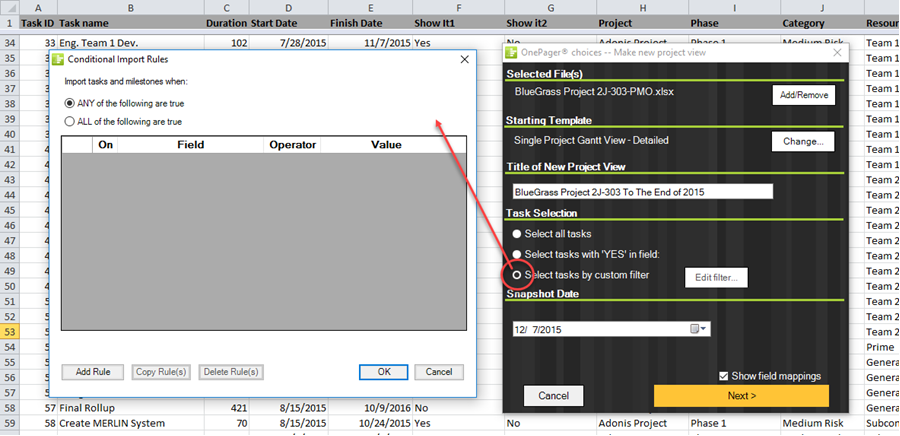
- a) The Conditional Import Rules form is shown in its initial blank state above. The rules entered become part of any project view subsequently created or updated and are saved with the project view. If you later, create or update a snapshot using a flag field, OPX will save the flag field and clear the Conditional Import Filters rules.
- b) Conditional Import Filter rules are typically entered when a project view is first created in the NEW workflow
- c) After a project view is created, rules may be added later for the UPDATE workflow via the OnePager Choices form invoked either from the OnePager Start form or the Project View Editor (Custom Update… button. These workflows are described later in this article.
2) With the Custom Import Rules form visible and blank, click the Add Rule button to create a new empty row as shown below:
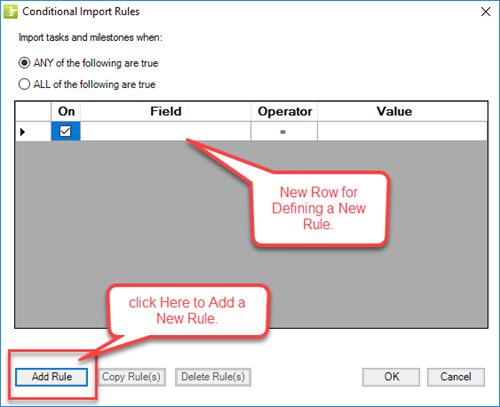
- a) There are five cells shown for the new rule row above. The first two cells are used as follows:
- i) The first two cells are used as selection cells.
- ii) The first left-most cell, when clicked, allows you to use the Copy Rule(s) or the Delete Rule(s) buttons.
- iii) The second cell from the left is a checkbox used to allow you to activate or deactivate the rule. If the checkbox is unchecked, OPX will not apply the rule when performing the import function.
- b) The Field cell of a row (third from the left) has a dropdown menu that allows you to select a Microsoft Excel source plan field to use in creating the selected criterion. When the dropdown menu is selected, the Field cell will look something like this:
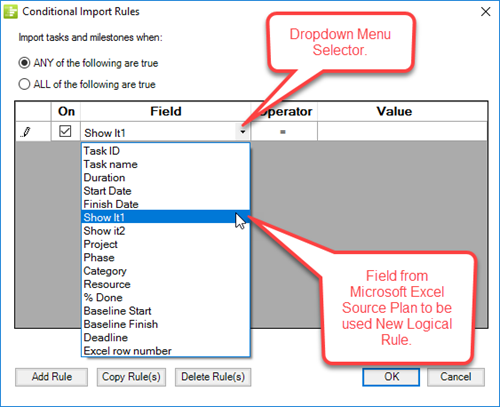
- c) When a Microsoft Excel source plan field is selected, the name will be displayed in the Field cell of the new Custom Import rule row.
- d) The look of the rest of the new Conditional Import Filters rule row depends on the type of the Microsoft Excel source plan field selected. These types are discussed next.
3) Date and Numeric Fields – When Microsoft Excel date or numeric types are selected in the Field cell of the rule row, the Operator field dropdown will provide the options shown below:
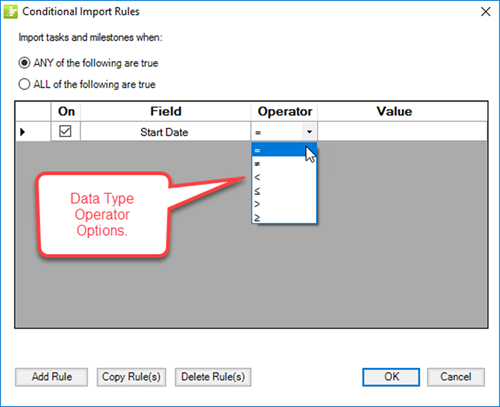
- a) These are the conventional six (6) logical operators used consistently in OPX for date and numeric types. They are the same Operators used in OPX for Conditional Formatting. See the article at Conditional Formatting Overview-OnePager Express for complementary details on the use of these logical operators.
- b) When the logical statement evaluates to TRUE on the selected Field in a Microsoft Excel source plan row, the row is imported. Otherwise it is skipped.
4) Text Fields – When Microsoft Excel text types are entered in the Field cell of the Conditional Import Filters rule row, the Operator field dropdown will provide the options shown below:
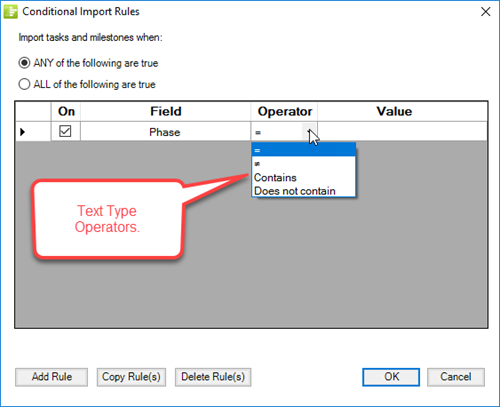
- a) These are the conventional four (4) logical operators used consistently in OPX for the text type. They are the same Operators used in OPX for Conditional Formatting. See the article at Conditional Formatting Overview-OnePager Express for complementary details on the use of these logical operators.
- b) When the logical statement evaluates to TRUE on the selected Field in a Microsoft Excel source plan row, the row is imported. Otherwise it is skipped.
5) Boolean Fields – When Microsoft Excel Boolean types are entered in the Field cell of the Conditional Import Filters rule row, the Operator field dropdown will provide the options shown below:
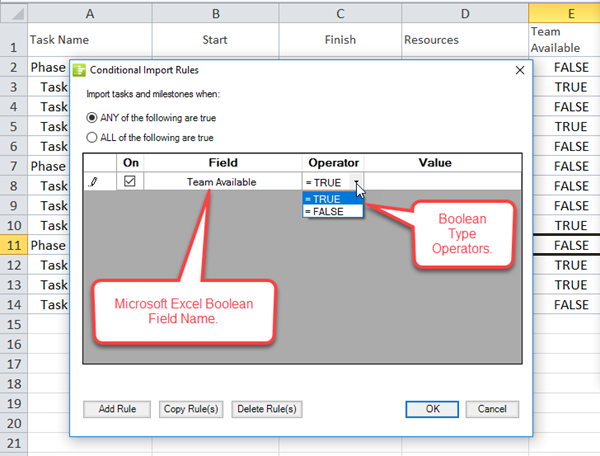
- a) These are the two (2) conventional Boolean logical operators used consistently in OPX for the Boolean type. They are the same Operators used in OPX for Conditional Formatting. See the article at Conditional Formatting with Boolean Fields for OnePager Express for complementary details on the use of these logical operators.
- b) Boolean types are a special case as the operator and the value in OPX are combined into one cell of the Conditional Import rule row - the Operator cell.
- c) When the selected Field is TRUE (or Yes) in a Microsoft Excel source plan row, the row is imported. Otherwise it is skipped.
6) Text Type Fields used as Flags – OPX treats Microsoft Excel Text type fields as flag fields to control row imports. Accordingly, when text type fields are used for Conditional Import Filters rules, OPX makes the import decisions based on whether the cell either contains or does not contain to required Value cell’s content as shown below:
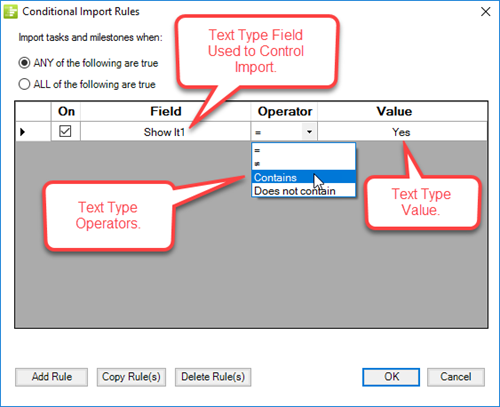
- a) In the case shown above, Microsoft Excel source plan rows will be imported only if the row contents of the Shot It1 Microsoft Excel source plan field contain a Yes.
- b) You may also use the equal or not equal Operators being careful that the Value contents in the Conditional Import Rules form row is exactly as specified in the Microsoft Excel source plan row.
- c) We want to emphasize the flexibility that Conditional Import Filters adds to the way you can import rows from your Microsoft Excel source plan. You can, therefore, formulate sets of Conditional Import Filters rules to controls imports using all available types of Microsoft Excel fields.
- d) For the logical statement to be TRUE, hence cause OPX to import the corresponding Microsoft Excel source plan row, the contents of the Operator cell in the Conditional Import Filters rule row must match the type and value in the Microsoft Excel source plan. Additionally, the logical relationship must be TRUE to make OPX act on the condition.
7) Boolean and Numeric Types Used as Flags in OnePager Express - OPX also recognizes Microsoft Excel Boolean types and Numeric types with 0 or 1 contents as Boolean types as well within the Conditional Import Rules form.
- a) OPX treats such Microsoft Excel Fields as Boolean types in the same way as described in the previous sub-section. When these Microsoft Excel types are entered in the Field cell of the Conditional Import Filters rule row, the Operator cell dropdown will provide the options as shown above.
- b) There are the two (2) conventional Boolean logical operators used consistently in OPX for the Boolean type. They are the same Operators used in OPX for Conditional Formatting. See the article at Conditional Formatting with Boolean Fields for OnePager Express for complementary details on the use of these logical operators.
- c) When the selected Field is TRUE (or Yes) in a Microsoft Project source plan row, the row is imported. Otherwise it is skipped.
7) We want to emphasize the flexibility that Conditional Import Filters adds to the way you can import rows from your Microsoft Excel source plan. You can formulate sets of Conditional Import Filters rules to controls imports using all available types of Microsoft Excel fields and use operators that let you select ranges of values and more complicated combinations of criteria.
Editing an Existing Filter Rule in the Conditional Import Rules Form
8) Suppose you’ve composed several Conditional Import Filters rules in an open Conditional Import Rules form as shown below:
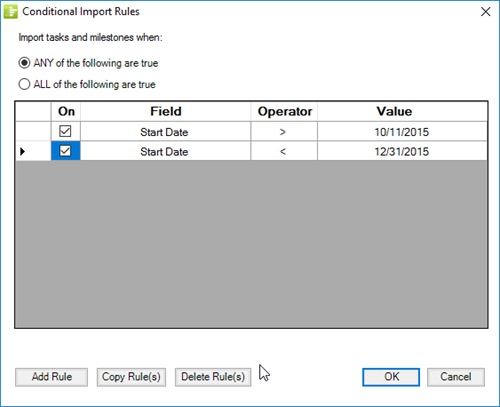
- a) Now further suppose, after reviewing these two rules, that you realize that you may not be able to capture any tasks/milestones that happen to Start on 12/31/2015 because the current rule is based on the less than logical Operator.
- b) To make the change in the Operator cell, click on the cell’s contents which will highlight the cell in blue and reveals the dropdown menu button which you should click. When you do the Conditional Import Rules form should look like this:
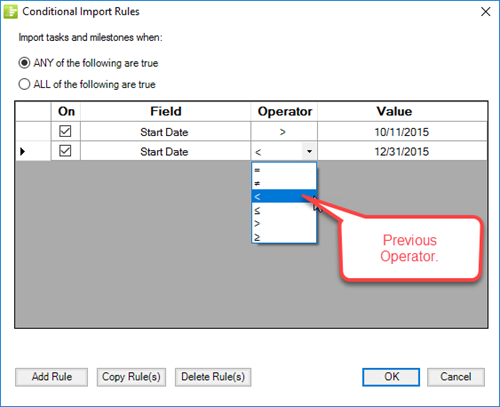
- c) To change the rule, click the desired Operator in the dropdown menu, in this case the less than or equal Operator, and it will be displayed in the Operator cell of the second rule as shown here:
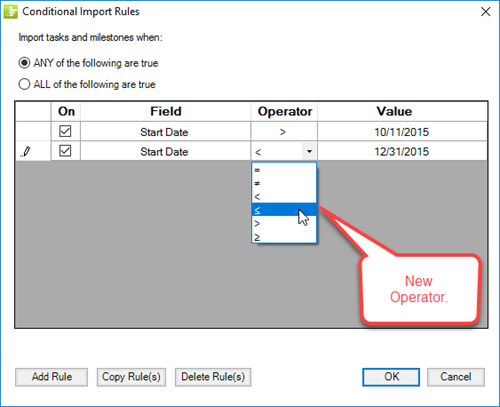
- d) Any Field, Operator, or Value cell may be edited in this way. Additionally, the On cell may be toggled to control the Conditional Import rule's participation in the import process. Finally, you may switch between the two radio buttons at the top of the form in order to change the relationship among the rules from OR to AND or vice versa.
- e) The edits described above may be made to the Conditional Import Rules form regardless of the OPC mode in which you are working (i.e., NEW and UPDATE). Also, you may bring up the Conditional Import Rules form from the OPC form as many times as needed to accomplish your presentation goal. OPX saves the content of the last edit you make to the Conditional Import Rules form.
- f) When satisfied with the structure of your import rules, click the OK button at the bottom of the form to return to the OPC form. Now you are ready to create a new project view.
Copying an Existing Filter Rule in the Conditional Import Rules Form
9) The Copy Rule(s) button is provided in the Conditional Import Rules form to facilitate the creation of additional rules.
- a) To copy a rule to create a new rule, first select the rule row from which you wish to copy as shown below:
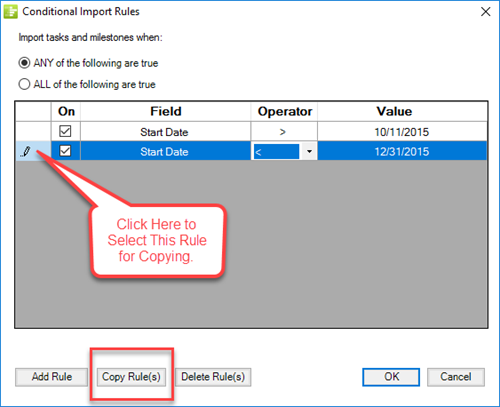
- b) Once the desired row is selected, clicking the Copy Rule(s) button will copy the contents of the rule selected as indicated by the highlighted left-most cell in the desired rule as shown below:
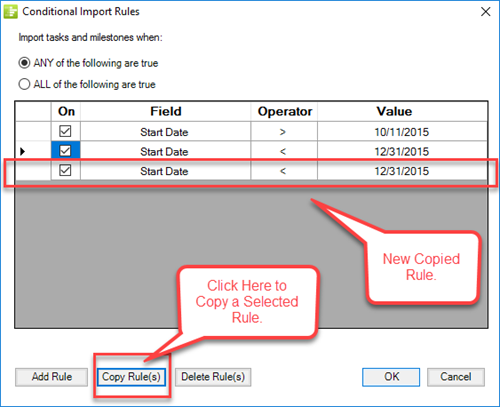
- c) At this point you may edit the copied row in the manner described previously. When you are finished, the new set of three rule rows may look like this:
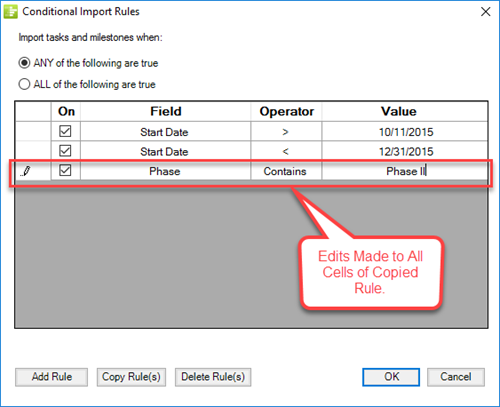
- d) When satisfied with the structure of your import rules, click the OK button at the bottom of the form to return to the OPC form. Now you are ready to create a new project view.
Deleting an Existing Filter Rule in the Conditional Import Rules Form
10) There are times when a particular Conditional Import rule will no longer serve its purpose. You can select the rule row to be deleted and click the Delete Rule(s) button.
- a) The process for deleting a rule parallels the process for copying a rule row in that the you must select the desired row to delete by clicking the left-most cell in that rule’s row.
- b) Once the selection is made, click the Delete Rule(s) button and OPX will first put up a warning message asking if you really want to delete the rule row as shown below:
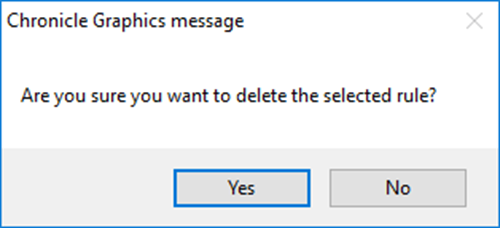
- c) If you select the No option, OPX will abandon the rule deletion operation and the warning message will disappear leaving the selected rule row still selected.
- d) If you select the Yes option, OPX will remove the warning message, delete the selected rule row, and leave the Conditional Import Rules form showing the remaining rule rows, if any.
- e) When satisfied with the structure of your import rules, click the OK button at the bottom of the form to return to the OPC form.
Using Conditional Import Filters Rules When Creating NEW Project Views
1) Using Conditional Import rules in the process of creating a NEW project view was partially covered in the first section above (Overview). In this section we’ll add a bit more detail.
Using Conditional Import Filters Rules from the OnePager Start Form’s NEW Mode
2) When creating a NEW project view, follow the workflow process provided in this article: Creating a NEW Project View - OnePager Express Add-in .
- a) First, launch Microsoft Excel and load the desired Microsoft Excel source plan. Then, click the OnePager Pro button on the Microsoft Excel tool bar to reveal the OnePager Start form shown below:
- b) Then, click the NEW button on the OnePager Start form shown below:
Switching from Flag Fields to New Conditional Import Filters Rules
- c) When you click the NEW button, the OPC form will appear as shown below. The process for building a new project view with Conditional Import Filters is the same with the exception that instead of using flag fields from your Microsoft Excel source plan you will, instead, invoke the Conditional Import Rules form from the OPC form as shown below:

- d) In the illustration above, in the Task Selection section of the form, the Select task by custom filter radio button is clicked. This action brings up the Conditional Import Rules form also shown above.
- e) At this point you may Add Rules to the form, Copy Rules, Delete Rules or edit existing rules.
Switching from Conditional Import Filters Rules to Flag Fields or Selecting all Tasks
3) If you subsequently decide after composing one or more Conditional Import Filters rules and clicking OK on the Conditional Import Rules form that you want to use flag fields instead, you may revert back to either of the two other Task Selection options provided in the OPC form shown above.
- a) To do this, click either of the other two radio buttons to Select all tasks, or Select task with ‘Yes’ in field:
- b) When you click the Select all tasks button there is no further action you need to take on the OPC form save entering the project view name and selecting a Snapshot Date as required. Creating the project view is a matter of clicking the Create new project view button at the bottom of the OPC form.
- c) However, if you click the Select tasks with ‘Yes’ in field: you will be asked to select a field from your Microsoft Excel source plans as shown below:
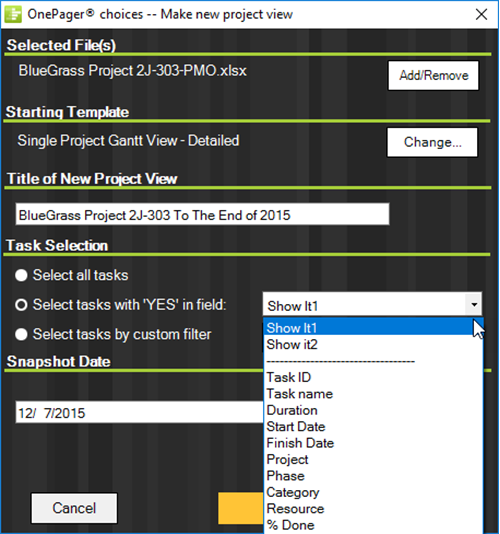
- d) When you have selected the desired flag, updated the project view name, and/or updated the snapshot date, you are ready to create the project view.
- e) In these circumstances where you’ve switched from using Conditional Import Filters rules to either selecting all tasks, or selecting tasks using a flag field, OPX will discard any Conditional Import Filters rules associated with the project view.
Adding, Editing, Copying, and Deleting Conditional Import Filters Rules
- 4) Managing Conditional Import rules was discussed in previous sub-sections of this article. Please follow the reference links provided below for details on adding, editing, copying, and deleting of Conditional Import rules:
- a) Adding a new rule: Adding a Filter Rule to the Conditional Import Rules Form.
- b) Editing an existing rule: Editing an Existing Filter Rule in the Conditional Import Rules Form.
- c) Copying a rule: Copying an Existing Filter Rule in the Conditional Import Rules Form.
- d) Deleting a rule: Deleting an Existing Filter Rule in the Conditional Import Rules Form.
Using Conditional Import Filters Rules When UPDATING a Project Views
Conditional Import Filters can also be done in the OPX UPDATE mode regardless of whether the original project view was itself created with Conditional Import Filters rules.
- (1) Normally, when UPDATING a project view with Conditional Import Filters rules, this will be done when the OPC form is invoked from the OnePager Start form when the UPDATE button is clicked.
- (2) However, it is also possible to update a project view from the Project View Editor (PVE) as we will also explain in this sub-section.
Using Conditional Import Filters Rules from the OnePager Start Form’s UPDATE Mode
1) After a project view is created either with or without Conditional Import Filters rules, it is still possible to update the next and following snapshots in a project view with Conditional Import Filters rules.
- a) Suppose we have a project view that was created and used previously and originally built using Microsoft Excel flag fields to control the import of tasks and milestones to the project view. By making a change to the OPC form when the update process is started, you can change the new snapshot in the project view to show different tasks by using Conditional Import Filters rules to replace the previously used Microsoft Excel flag fields. This update can be applied either to create a NEW snapshot or REPLACE an existing snapshot.
- b) First, launch Microsoft Excel with the designated Microsoft Excel source plan and click the OnePager Express button on the Microsoft Excel tool bar. This brings up the OnePager Start form where you should click the UPDATE button and select the project view from either the RECENT or the BROWSE FILES… option as shown below:
- c) The project view selected was originally created using a Microsoft Express flag field as shown in the OPC form which appeared after the above UPDATE button is clicked and the project view selected from the RECENT list show above. The OPC form is shown below:
- d) Make sure that you have selected either the NEW or REPLACE mode in the Snapshot Date section of the OPC form and set the appropriate snapshot date.
- e) Then, to begin that portion of the process to use Conditional Import Filters rules, click the Select tasks by custom filter radio button which immediately brings up the Custom Import Rules form which is blank as shown below:
- f) You are now ready to create your Conditional Import Filters rules.
2) Please refer to the following sub-section of this article for guidance on adding, editing, copying, and deleting Conditional Import rules: Adding, Editing, Copying, and Deleting Conditional Import Filters Rules.
3) Clicking the New button in the OPC form above will create a new snapshot with the appropriate snapshot date using the Conditional Import Filters rules you’ve specified.
- a) Only this new snapshot will have a look corresponding to the Microsoft Excel source plan rows imported under the control of the Conditional Import Rules form.
- b) Warning: Since OPX only maintains one source plan row selection mechanism, previous snapshots may take on a different set of tasks/milestones, swimlanes, and row text columns. Accordingly, great care should be taken when adopting this process.
- c) As long as new subsequent snapshots are created with the current set of Conditional Import Filters rules, these snapshots will have the same Microsoft Excel source plan rows imported.
4) Snapshots that are REPLACED will take on the look of snapshots controlled by the current set of Conditional Import Filters rules.
5) Later on, perhaps after the new project view was updated several times in later Microsoft Excel source plan update cycles, you may want to go back to using Microsoft Excel flag fields.
- a) If this becomes require, simply repeat the front end of the UPDATE process and when the OPC form appears click the Select all tasks radio button.
- b) You can also choose to click the Select tasks with ‘Yes’ in field: radio button and select the appropriate flag field from the dropdown menu which is available.
- c) In either of the above two cases, OPX will clear all the Conditional Import Filters rules that were in the Conditional Import Rules form so that they will not be available later.
6) The UPDATE process allows you to create a NEW snapshot at date… as well as REPLACE existing snapshots at date….
- a) If Conditional Import Filters rules are being used (active) at the time the current snapshot is being readied for processing in the PVE and after the New or Replace… button is clicked at the bottom of the OPC form, the Conditional Import Filters rules will be applied regardless of whether the New or Replace… option is selected.
- b) Warning: Since OPX only maintains one source plan row selection mechanism, previous snapshots may take on a different set of tasks/milestones, swimlanes, and row text columns. Accordingly, great care should be taken when adopting this process.
Using Conditional Import Filters Rules with the Custom Update… Button on the Data Tab in the UPDATE Mode
7) In the previous sub-section, setting up to do a Conditional Import Filters of an existing project view was done from the OPC form which allows you to do the import before the project view is turned over to the PVE for display and editing. OPX also supports setting up and performing Conditional Imports Filters after the project view under UPDATE is already displayed in the PVE.
- a) Suppose, we have a project view that we want to update that was previously built using a Microsoft Excel flag field to control the import. Further, suppose, that this project view was previously updated through several cycles such that it now contains several snapshots all produced with the same Microsoft Excel flag field controlling the import.
- b) Finally, suppose that you want to produce another snapshot again using the same flag field to initially control the import, but after the project view reaches the PVE you would like to “experiment” with the graph by importing other rows from the Microsoft Excel source plan.
- c) Now with this scenario in mind, we can use the ADD a Snapshot workflow (See the article at: ADDING a Snapshot via Pull Operation - OnePager Express) to get the project view into the PVE under control of the existing flag field. Once the project view is in the PVE we can then perform an update to bring additional rows from the Microsoft Excel source plan to “experiment” with the project view.
8) First launch Microsoft Excel with the desires source plan. Then click the OnePager button on the Microsoft Excel tool bar which brings up the OnePager Start form you are familiar with. At this point, click the UPDATE button as shown below and select the desired project view you want to update from the RECENT list:
- a) Selecting this project view for update with the UPDATE button shown above will bring up the OPC form shown below:
- b) At this point you want to create a new snapshot using Conditional Import Filters rules. To do this, first make sure that the NEW snapshot at date radio button is selected in the Snapshot Date section of the above for and set the snapshot date to a new date as shown below:
- c) Now, click the New button at the bottom of the OPC form. This action will create a new snapshot with the new snapshot date shown above. This new snapshot is shown below:
- d) Now with the new snapshot showing in the PVE, go to the Data tab and click the Custom Update button as shown here:
- e) Next, click the Select task by custom filter button in the Task Selection section of the OPC form. This action will bring up an empty Custom Import Rules form as shown here:
- f) In the Conditional Import Rules form add the rules you require to make the new snapshot display the rows you need the Microsoft Excel source plan as we’ve done below:
- g) When the Conditional Import Filters rules are satisfactory, click the OK button at the bottom of the form which will collapse the Conditional Import Rules form into the OPC form. Now, click the New button on the OPC form to create the new snapshot as shown below:
- h) The updated project view above is a snapshot created from the open Microsoft Excel source plan using the import controls you specified in the Conditional Import Rules form you accessed. Other snapshots are unchanged as this is a new snapshot. However, the process works similarly for Replacing an existing snapshot.
9) Care must be taken when REPLACING a snapshot to assure that OPX will have access to the correct Microsoft Excel source plan corresponding to the snapshot date you wish to replace.
- a) Warning: Since OPX only maintains one source plan row selection mechanism, previous snapshots may take on a different set of tasks/milestones, swimlanes, and row text columns. Accordingly, great care should be taken when adopting this process.
- b) Using Conditional Import rules can, therefore, be considered the same as using flag fields with it comes to creating/replacing snapshots.
Using Conditional Import Filters Rules When OPENING a Project Views
Conditional Import Filters can also be done in the OPX OPEN mode regardless of whether the original project view was itself created with Conditional Import Filters rules.
- (1) Normally, when OPENING a project view with Conditional Import Filters rules, this will be done when the OPC form is invoked from the OnePager Start form when the OPEN button is clicked.
- (2) As seen from the discussion in the previous section Using Conditional Import Filters Rules with the Custom Update Button… on the Data Tab in the UPDATE Mode, it is also possible to update a project view from the Project View Editor (PVE).
Using Conditional Import Filters Rules from The OnePager Start Form’s OPEN Mode
1) After a project view is created either with or without Conditional Import Filters rules, it is still possible to update the next and following snapshots in a project view when Opening the project view.
- a) Suppose we have a project view that was created, used previously, and originally built using Microsoft Excel flag fields to control the import of tasks and milestones. By making a change to the OPC form after the project view is opened, it is possible to change the new snapshot in the project view to show different tasks by using Conditional Import Filters rules to replace the previously used Microsoft Excel flag fields. This update can be applied either to create a NEW snapshot or REPLACE an existing snapshot.
- b) First, launch Microsoft Excel with the designated Microsoft Excel source plan and click the OnePager Express button on the Microsoft Excel tool bar. This brings up the OnePager Start form where you should click the OPEN button and select the project view from either the RECENT or the BROWSE FILES… option as shown below:
- c) The project view selected was originally created using a Microsoft Excel flag field. The project view is shown below:
- d) To satisfy you need to create a new snapshot controlled by some more complex import rules, you will need to click the Custom Update… button shown in the red box in the illustration above. When you do this the OPC form will appear as shown here:
- e) Make sure that you have selected either the NEW or REPLACE mode in the Snapshot Date section of the OPC form and set the appropriate snapshot date.
- f) Then, to begin that portion of the process to use Conditional Import Filters rules, click the Select tasks by custom filter radio button which immediately brings up the Custom Import Rules form which is blank as shown below:
- g) You are now ready to create your Conditional Import Filters rules.
2) Please refer to the following sub-section of this article for guidance on adding, editing, copying, and deleting Conditional Import Filters rules: Adding, Editing, Copying, and Deleting Conditional Import Filters Rules.
3) We’ve gone ahead and added two Conditional Import rules to the Conditional Import Rules form as shown below:
- 4) Clicking the New button in the OPC form above will create a new snapshot with the appropriate snapshot date using the Conditional Import Filters rules you’ve specified.
- a) Only this new snapshot will have a look corresponding to the Microsoft Excel source plan rows imported under the control of the Conditional Import Rules form.
- b) Warning: Since OPX only maintains one source plan row selection mechanism, previous snapshots may take on a different set of tasks/milestones, swimlanes, and row text columns. Accordingly, great care should be taken when adopting this process.
- c) As long as new subsequent snapshots are created with the new set of Conditional Import Filters rules, these snapshots will have the same Microsoft Excel source plan rows imported.
- d) The new snapshot under the control of the Conditional Import Filters rules now looks like this:
5) Snapshots that are REPLACED will take on the look of snapshots controlled by the current set of Conditional Import Filters rules.
6) Later on, perhaps after the new project view was updated several times in later Microsoft Excel source plan update cycles, you may want to go back to using Microsoft Excel flag fields.
- a) If this is require, simply repeat the front end of the UPDATE process and when the OPC form appears click the Select all tasks radio button.
- b) You can also choose to click the Select tasks with ‘Yes’ in field: radio button and select the appropriate flag field from the dropdown menu which is available.
- c) In either of the above two cases, OPP will clear all the Conditional Import Filters rules that were in the Conditional Import Rules form so that they will not be available later.
7) The UPDATE process allows you to create a NEW snapshot at date… as well as REPLACE existing snapshots at date….
- a) If Conditional Import Filters rules are being used (active) at the time the current snapshot is being readied for processing in the PVE and after the New or Replace… button is clicked at the bottom of the OPC form, the Conditional Import Filters rules will be applied regardless of whether the New or Replace… option is selected.
- b) Warning: Since OPX only maintains one source plan row selection mechanism, previous snapshots may take on a different set of tasks/milestones, swimlanes, and row text columns. Accordingly, great care should be taken when adopting this process.
Using Conditional Import Filters Rules with the Custom Update… Button on the Data Tab in the OPEN Mode
8) In the previous sub-section, setting up to do a Conditional Import Filters of an existing project view was done from the OPC form which allows you to do the import before the project view is turned over to the PVE for display and editing. OPX also supports setting up and performing Conditional Imports after the project view is already OPENED and displayed in the PVE.
- a) Suppose, we have a project view that we want to update that was previously built using a Microsoft Excel flag field to control the import. Further, suppose, that this project view was previously updated through several cycles such that it now contains several snapshots all produced with the same Microsoft Excel flag field controlling the import.
- b) Finally, suppose that you want to produce another snapshot again using the same flag field to initially control the import, but after the project view reaches the PVE you would like to “experiment” with the graph by importing other rows from the Microsoft Excel source plan.
- c) Now with this scenario in mind, we can use the ADD a Snapshot workflow (See the article at: ADDING a Snapshot via Pull Operation - OnePager Express) to get the project view into the PVE under control of the existing flag field. Once the project view is in the PVE we can then perform an update to bring additional rows from the Microsoft Excel source plan to “experiment” with the project view.
9) To accomplish this, first launch Microsoft Excel with the desires source plan. Then click the OnePager button on the Microsoft Excel tool bar which brings up the OnePager Start form you are familiar with. At this point, click the OPEN button as shown below and select the desired project view you want to open from the RECENT list:
a) When the project view is opened, it will look like this:
- b) To satisfy your need to create a new snapshot controlled by some more complex import rules, you will need to click the Custom Update… button shown in the red square in the illustration below. When you do this the OPC form will appear as shown here:
- c) Make sure that you have selected either the NEW or REPLACE mode in the Snapshot Date section of the OPC form and set the appropriate snapshot date.
- d) Then, to begin that portion of the process to use Conditional Import Filters rules, click the Select tasks by custom filter radio button which immediately brings up the Custom Import Rules form which is blank as shown below:
- e) You are now ready to create your Conditional Import Filters rules.
10) Please refer to the following sub-section of this article for guidance on adding, editing, copying, and deleting Conditional Import rules: Adding, Editing, Copying, and Deleting Conditional Import Filters Rules.
11) We’ve gone ahead and added two Conditional Import Filters rules to the Conditional Import Rules form as shown below:
12) Clicking the New button at the bottom of the OPC form above will create a new snapshot with the appropriate snapshot date using the Conditional Import Filters rules you’ve specified.
- a) Only this new snapshot will have a look corresponding to the Microsoft Excel source plan rows imported under the control of the Conditional Import Rules form.
- b) Warning: Since OPX only maintains one source plan row selection mechanism, previous snapshots may take on a different set of tasks/milestones, swimlanes, and row text columns. Accordingly, great care should be taken when adopting this process.
- c) As long as new subsequent snapshots are created with the new set of Conditional Import Filters rules, these snapshots will have the same Microsoft Excel source plan rows imported.
- d) The new snapshot under the control of the Conditional Import Filters rules now looks like this:
13) Snapshots that are REPLACED will take on the look of snapshots controlled by the current set of Conditional Import Filters rules.
14) Later on, perhaps after the new project view was updated several times in later Microsoft Excel source plan update cycles, you may want to go back to using Microsoft Excel flag fields.
- a) If this becomes require, simply repeat the front end of the UPDATE process and when the OPC form appears click the Select all tasks radio button.
- b) You can also choose to click the Select tasks with ‘Yes’ in field: radio button and select the appropriate flag field from the dropdown menu which is available.
- c) In either of the above two cases, OPP will clear all the Conditional Import Filters rules that were in the Conditional Import Rules form so that they will not be available later.
15) The UPDATE process allows you to create a NEW snapshot at date… as well as REPLACE existing snapshots at date….
- a) If Conditional Import Filters rules are being used (active) at the time the current snapshot is being readied for processing in the PVE and after the New or Replace… button is clicked at the bottom of the OPC form, the Conditional Import Filters rules will be applied regardless of whether the New or Replace… option is selected.
- b) Warning: Since OPX only maintains one source plan row selection mechanism, previous snapshots may take on a different set of tasks/milestones, swimlanes, and row text columns. Accordingly, great care should be taken when adopting this process.
- c) Furthermore, since Conditional Import Filters is snapshot dependent, and as mentioned earlier, only the snapshot in the PVE will be impacted.
Using Conditional Import with a Microsoft Excel Source Plan with Multiple Projects
1) A Microsoft Excel source plan may be structured such that multiple projects/spreadsheet can be processed by OPX as a single entity.
- a) When a flag field is used to control the import of rows from a Microsoft Excel source plan containing multiple projects, that flag field is applied to every single project in the Microsoft Excel source plan.
- b) When Conditional Import rules are being used to control the import of a Microsoft Excel source plan containing multiple projects, the defined Conditional Import Rules form controls the import of rows from that single Microsoft Excel source plan.
2) As a refresher please consult this article for information on how OPX builds graphs from multiple projects in a single Microsoft Excel source plan at: Handling Microsoft Excel Spreadsheets Containing Multiple Projects .
3) The instructions provided in this article for single Microsoft Excel source plans with respect to the OPX modes of NEW, UPDATE, and OPEN apply to import from a Microsoft Excel source plan containing multiple projects/spreadsheets.
Using Conditional Import with Multiple Separate Microsoft Excel Source Plan Packages
1) Microsoft Excel source plans that are grouped into packages for processing by OPX are treated as a single source plan entity from the perspective of import to OPX.
- a) When a flag field is used to control the import of rows from multiple, separate Microsoft Excel source plans grouped by OPX into a package, that flag field is applied to every single multiple Microsoft Excel source plan uniformly in the package.
- b) When Conditional Import rules are being used to control the import of separate Microsoft Excel source plans grouped by OPX into a package, the defined Conditional Import Rules form controls the import of rows from each of the separate Microsoft Excel source plans in turn.
2) As a refresher please consult this article for information on how OPX builds graphs from multiple separate Microsoft Excel source plans at: Making Multi-Project Graphs from Separate Microsoft Excel Plans .
3) The instructions provided in this article for single Microsoft Excel source plans with respect to the OPX modes of NEW, UPDATE, and OPEN apply to import from separate multiple Microsoft Excel source plans.
Related Links
Conditional Formatting (Portal)
Using the OnePager "Data" Tab's "Selected file(s)" Button
OnePager Express Import of Data from Microsoft Excel
Message to Assist with Setting Import Flags When No Data Are Imported
Understanding Project Views and Snapshots for OnePager Pro
Understanding Project Views and Snapshots for OnePager Express
(7.18.2.1-60)